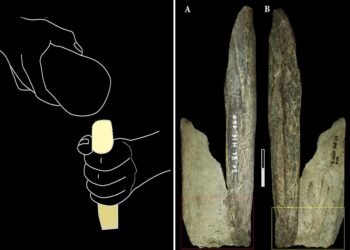Recent excavations in Sandomierz-Mokoszyn, located in Poland’s Świętokrzyskie region, have unveiled one of the earliest examples of a Neolithic “long house” on the Sandomierz Upland. Dating back to between 5300 and 4900 BCE, this remarkable discovery marks a significant contribution to understanding the Neolithic period in Central Europe.
The excavation project, conducted by the Three Ages studio from Klimontów, was originally launched to confirm the presence of a Funnel Beaker culture settlement (3700-3200 BCE). This culture, known for large storage pits, pottery fragments, flint tools, stone querns, and animal bones, was already evidenced in the area. However, the archaeologists made an unexpected and earlier discovery: remnants of a Neolithic settlement from the Linear Pottery culture, which predates the Funnel Beaker culture.
The Linear Pottery culture, one of the earliest Neolithic cultures in Central and Eastern Europe, thrived from approximately 5500 to 4500 BCE. Its name is derived from the distinctive linear patterns found on ceramic vessels, often filled with white paste. These early farmers, believed to have migrated from the Transcarpathian region, settled in what is now Poland, and their way of life revolved around farming and animal husbandry.
At the center of the find was a “long house” measuring about 6 meters in width and over 20 meters in length. This post-and-beam structure, aligned along a north-south axis, represents the first known long house of its kind on the Sandomierz Upland. Similar structures have been previously identified in regions like Kujawy, Subcarpathia, and Lesser Poland, but this is the first instance in this area. Dr. Marek Florek, a representative of the Sandomierz delegation of the Provincial Office for Monument Protection, said, “The discovery of the longhouse is the first of its kind in the Sandomierz Upland. It indicates a permanent settlement in the early Neolithic period, rather than a temporary encampment.”
The team also unearthed evidence of continuous habitation in the area over thousands of years. Surrounding the long house, they discovered various utility pits, including clay pits from which material was sourced for building walls. Among the artifacts found were decorated ceramics, flint tools, and two pits containing objects made of obsidian, a volcanic glass imported from what is now Slovakia or Hungary. This suggests that the region was connected to distant trade routes during the Neolithic period.
In addition, a fragment of a Neolithic vessel from the Lublin-Volhynia culture was recovered, suggesting that the area witnessed multiple phases of settlement activity over time. According to Dr. Florek, “This is an interesting discovery, which confirms the continuity of settlement in this area over several thousand years.” He further noted that all the discovered artifacts will undergo scientific study before being transferred to the Sandomierz Castle Museum for preservation.
Source: Nauka w Polsce






















